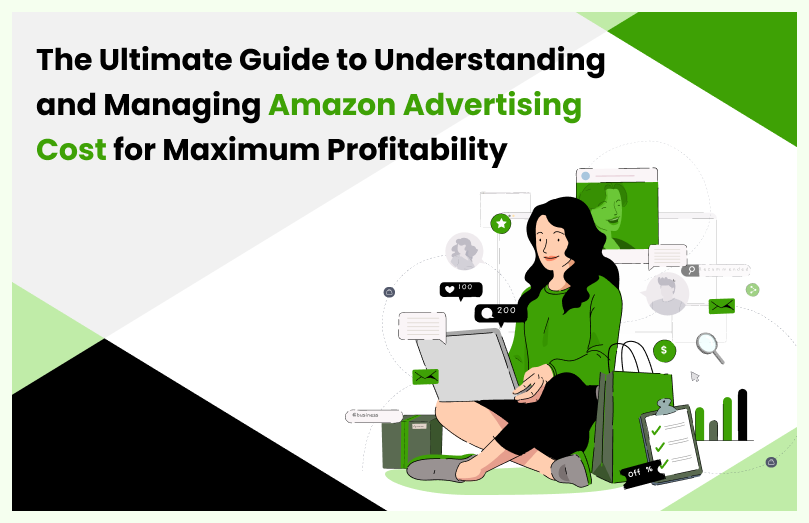In the vast realm of e-commerce, Amazon has emerged as a dominant force, providing unparalleled opportunities for businesses to showcase their products to a global audience. As an e-commerce seller, understanding Amazon ppc and various other types of amazon advertising is crucial for your success, allowing you to reach potential customers and drive sales. However, navigating the intricacies of Amazon’s advertising platform can be daunting, especially when managing your costs effectively to maximize profitability.
This comprehensive guide is designed to demystify the world of Amazon advertising costs, whether you are an independent seller, a brand owner, or a vendor on Amazon, this guide is your ultimate resource to unravel the complexities of Amazon advertising costs and take control of your advertising campaigns.
What Amazon Advertising Cost Actually Is?
You must have thought or wondered about the cost of Amazon advertising; how much does Amazon advertising cost? What is the Amazon advertising cost?
Well, we will be covering all this, but firstly, we will learn about what Amazon advertising cost actually is?
Amazon advertising costs refer to the expenses incurred by advertisers when running advertising campaigns on Amazon’s platform. The actual cost can vary depending on several factors, including the type of advertising campaign, targeting options, bidding strategies, competition, and other variables.
Advertising Options Offered By Amazon
Amazon offers various advertising options, and advertisers can choose the same as per their convenience, such as:
Sponsored Products
Advertisers promote their products with Sponsored Products within search results and on product detail pages. The cost is based on a pay-per-click (PPC) model, where advertisers will only charge when users click on their ad. The average cost per click can vary based on keyword competitiveness and bidding strategies.
Sponsored Brands
Sponsored Brands allow advertisers to showcase their brand and a selection of products in a prominent manner. These ads can appear in search results and feature the brand logo, customizable headline, and multiple product images. Like Sponsored Products, the cost is typically based on a PPC model.
Sponsored Display
Sponsored Display enables advertisers to reach audiences both on and off Amazon. This option allows displaying ads on product detail pages, search results, and other placements. The cost is typically based on a PPC model.
It’s worth noting that Amazon uses an auction system to determine the placement of ads. Advertisers compete with one another by bidding on keywords and placements, and factors, including bid amounts, ad relevance, and competitiveness, affect the cost. Advertisers also control their campaign budgets, allowing them to set daily or lifetime spending caps.
How Much Does Amazon Advertising Cost?
When it comes to Amazon advertising costs, it’s crucial to dive deep into the various components that contribute to them, it includes:
Bid Prices
Bid prices refer to the maximum amount an advertiser is willing to pay for each click on their ad. Advertisers participate in auctions to secure ad placements, and the bid prices they set directly impact their advertising costs.
Click-Through Rate (CTR)
CTR measures the percentage of people who click on an ad after seeing it. It is calculated by dividing the number of ad clicks by the number of ad impressions. CTR is important as it indicates the effectiveness and relevance of an ad, which can influence both the ad’s performance and costs.
Cost-Per-Click (CPC)
CPC represents the actual cost incurred by advertisers for each click on their ads. It is determined by factors such as bid prices, ad relevance, and competition. Advertisers are charged this amount every time a user clicks on their ad.
Cost-Per-Acquisition (CPA)
CPA refers to the cost incurred by advertisers for acquiring a customer or generating a conversion, such as a purchase or sign-up. It is calculated by dividing the total advertising costs by the number of conversions. CPA helps assess the profitability of advertising campaigns by considering the actual outcomes and costs associated with conversions.
It’s crucial to create a balance between bid pricing, CTR, CPC, and CPA in order to maximize profitability. Advertisers may reduce costs and improve returns on their advertising efforts by experimenting with bid modifications, fine-tuning ad targeting, optimizing ad creatives, and tracking performance indicators. Campaigns with greater conversion rates, increased profitability, and regular monitoring and modification based on these factors can all benefit from the Amazon advertising ecosystem.
Additionally, on average, the cost-per-click (CPC) for Amazon advertising can range from $0.10 to $5 or more, depending on the competitiveness of the targeted keywords and product category. However, it’s crucial to understand that these figures are approximate and can vary significantly.

Factors Influencing Amazon Advertising Costs
Several key factors influence advertising costs on Amazon, and understanding them is essential for effective cost management and optimizing advertising campaigns. Let’s dive into these factors and discuss how they impact costs, along with tips on managing them effectively:
Competition
The level of competition within your product category plays a significant role in advertising costs. Higher competition often leads to increased bid prices as advertisers vie for ad placements. To manage costs, focus on targeting niche or less competitive keywords and refine your targeting options to reach a more specific audience.
Bid Strategies
The bid strategy you choose can impact your advertising costs. Manual bidding allows you to set your own bid amounts, while automatic bidding allows Amazon’s algorithm to adjust bids based on competitiveness. Experiment with different bid strategies and monitor performance closely to find the right balance between cost and performance.
Targeting Options
The targeting options you select can influence costs. Highly competitive or popular keywords and targeting options may require higher bids to secure ad placements. Analyze the performance of different targeting options and focus on those that yield better results while keeping costs in check.
Ad Placement
The placement of your ads on Amazon’s platform affects costs. Prominent ad placements, such as top-of-search or above-the-fold positions, generally command higher bid prices. Consider a mix of placements and test the performance of different ad placements to find the sweet spot between visibility and costs.
Seasonality
Seasonal fluctuations can impact advertising costs. During peak shopping seasons or specific holidays, competition intensifies, leading to higher bid prices and increased costs. Anticipate these fluctuations and plan your advertising budget accordingly to avoid overspending during high-cost periods.
Ad Performance
The performance of your ads directly impacts costs. Ads with higher click-through rates (CTR) and conversion rates tend to achieve better ad placement and may result in lower costs per click (CPC) or cost per acquisition (CPA). Continuously optimize your ad content, targeting, and landing pages to improve ad performance and reduce costs.
Additionally, staying updated with industry trends, leveraging Amazon’s advertising tools and features, and conducting thorough competitor research can provide valuable insights for managing costs effectively. Continuously test and refine your strategies to find the optimal approach that maximizes profitability while keeping advertising costs under control.
Bid Optimization Techniques
Bid optimization is a crucial aspect of managing Amazon advertising costs and maximizing profitability. By strategically adjusting bids, advertisers can control costs while maximizing the effectiveness of their campaigns.
Let’s explore different bid optimization techniques and how they can help achieve these goals:
Bid Adjustments Based on Performance Data
Analyzing performance data is essential for bid optimization. Identify keywords, products, or targeting options that yield higher conversion rates or better return on ad spend (ROAS). Increase bids for these high-performing elements to maintain or improve their visibility and capitalize on their success. Conversely, reduce bids or pause underperforming elements to minimize costs.
Bid Modifiers for Different Targeting Options
Amazon provides various targeting options, such as by location, device, or audience segment. Adjusting bids based on the performance of specific targeting options can help optimize costs. For instance, if certain geographic locations or devices generate higher conversions, increase bids for those segments to maximize visibility and potential sales.
Automated Bid Management
Leveraging automation tools can streamline bid optimization. Amazon offers features like bid automation and dynamic bidding strategies that adjust bids in real time based on predetermined rules or algorithms. Automated bid management can help save time, improve efficiency, and ensure bids are adjusted promptly to align with performance goals.
Time-Based Bidding
Analyze your campaign performance across different times of the day or days of the week. Identify periods when your ads perform exceptionally well or when conversion rates are higher. Implement bid adjustments to increase or decrease bids during these specific timeframes to optimize costs and maximize profitability.
Remember that bid optimization is an ongoing process, and strategies that work for one campaign may not necessarily work for another. Continuously test, refine, and adapt your bid optimization techniques to find the most effective approach for your specific products, target audience, and advertising goals.
Final Thoughts
In conclusion, understanding and managing Amazon’s advertising costs is crucial to profitability on the platform. By following the best practices outlined in this guide, including setting clear goals, analyzing data, optimizing campaigns, and monitoring performance regularly, sellers can succeed tremendously with their advertising efforts.
It’s essential to keep in mind that there is no one-size-fits-all approach and that experimentation and adaptation are key to finding the most effective strategies for your business. With the right mindset and tools in place, sellers can navigate the complexities of Amazon advertising and achieve sustainable growth over time.
MMF Infotech specializes in providing advertising services, especially Amazon sponsored ads services that can help you manage and understand the costs associated with advertising on the world’s largest online marketplace. With our powerful tools and expert guidance, you can optimize your advertising campaigns and increase your revenue in no time.
So why wait? Sign up with MMF Infotech today and start seeing results!


